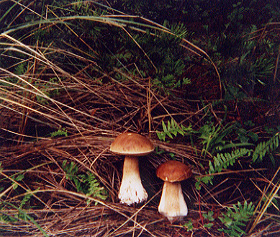 'Shrooming
'Shrooming
How to get started:
Warning: Do not eat ANYTHING (including but not limited to mushrooms) that you have picked, bought, or been given UNLESS YOU ARE ABSOLUTELY SURE OF ITS IDENTIFICATION!
I write the above not only as a disclaimer but as an attempt to place fungi on equal footing with other foods. There are deadly poisonous mushrooms out there. There are also deadly poisonous plants. Mushrooms which are edible may cause adverse reactions in some people. So can plants and plant parts (you don't want to hear about my experience with rutabagas), meats, and food additives which are generally derived from plants. It is always best to be educated and cautious.
A Short 'Shroom Primer, my own introduction to mushrooms.
Besides taking a class or finding a knowledgeable person
to forage with, the following book will be very helpful if you live in
Western North America: Mushrooms Demystified, by David Arora (Ten
Speed Press: Berkeley, 1986). It is truly the mushroom hunter's bible for
our neck of the woods. Another book to check out, particularly if you are
most interested in eating mushrooms, is Edible
Wild Mushrooms of North America, by David Fischer and Alan Bessette.
Fischer and Bessette have also written a field guide to Mushrooms of Northeastern
North America, which should be out soon and will be an essential guide
for residents of that region. The Audubon Society's Field Guide to North
American Mushrooms is a good companion with lots of photographs, but
I wouldn't want to rely on it alone. Before picking on public lands,
it is usually best to check with the local authorities. In Oregon,
most National Forests require permits (usually at no charge for personal
use) which may have additional restrictions attached, and State Parks ban
picking altogether. These regulations have come about only recently, and
are mostly the result of a boom in the mushroom export market. With commercial
pickers bringing in thousands of dollars a week, it is not surprising that
the woods in some places have turned into a war zone. Destructive picking
techniques and greedy frenzies hurt the woods and make them a worse place
to be; think of it as fungal clearcutting. Recreational pickers have a
duty to abide by regulations so that we can distance ourselves from these
practices and possibly gain access to a wider selection of lands.
Web Sites
There are lots of mushrooms on the Web. If you're looking for
a site, check out the mighty lists of links at MykoWeb and mycoElectronica.
A truly awesome site for the beginning mushroomer is Mushroom
Heaven.
Add your name to the list of Mushroomers
Online! Visit Dave
Fischer's Mushroom Page while you're at it.
You can also browse my foray reports and my
list of local mushroom species. Although these
seem Portland-specific, they should be helpful to foragers in many areas.
| 'Shroom Page | Wild Plants Page | Fishin' Page |
| The Edible LC | Foray Reports | Links |
Back to Wes's Home Page.